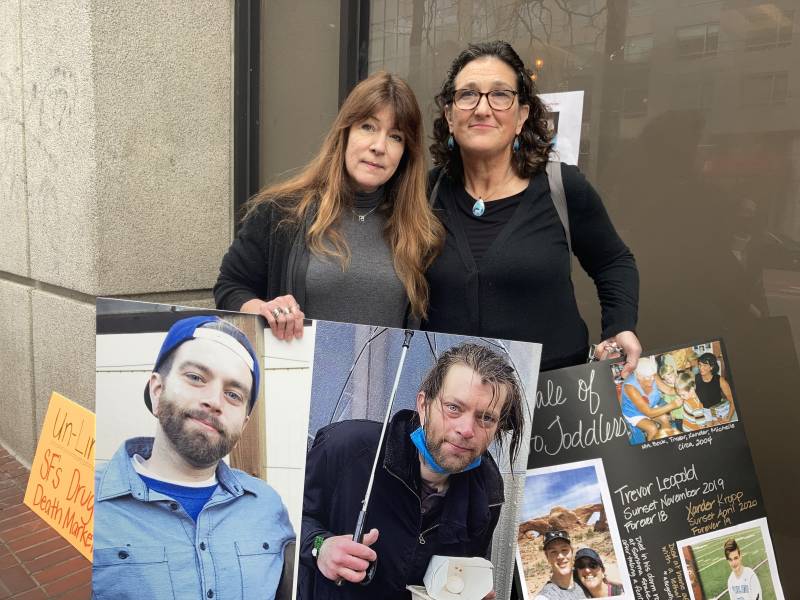A group of five mothers staged a protest on Saturday outside the Tenderloin Linkage Center to call for an end to drug use at the site. The center was set up as part of San Francisco Mayor London Breed’s emergency declaration to address a rise in drug overdoses. The site is meant to help connect people to drug treatment, housing and other services.
'What's the End Goal?': Mothers Protest Drug Use at the Tenderloin Linkage Center

The mothers who organized the protest have all been affected by the drug epidemic, and say they support the center but believe allowing drug use will make it more difficult for people to get help. People have been using drugs on the center property in a fenced-off area outside the building and have not been asked to leave.
“I think linking people to services is great and it’s way past time,” said Gina McDonald, a former heroin user whose daughter is in treatment for addiction. “If you want to open a safe consumption site, don’t do it here. You don’t offer services and allow open-air drug dealing in the same place. What’s the end goal?”
About a dozen people also arrived as part of a counterprotest in an effort to show support for the center, which they said has been effective at offering people the services they need.
On Tuesday, the San Francisco Board of Supervisors is holding a hearing over the emergency declaration that fast-tracked this site and sparked a debate over how best to address drug dealing and addiction.
Jacqui Berlinn is one of the organizers of the protest and founders of the group Mothers Against Drug Deaths. Her son, Corey, lives on the streets of San Francisco and is addicted to fentanyl. She says that when she heard about the linkage center, she was excited that her son might have a safe space to go and get some help.
But then when she learned people were using drugs at the site, she said, her heart dropped.
“I know that my son will say it’s just more of the same,” she said. “It’s just what the city’s been doing, enabling and encouraging. They’re not serious about helping them get well.”
Berlinn said that Corey did drop by the site, but left when he saw people in the fenced-off area outside the building using drugs.
“My hope was that it was going to be a safe space for him just to have 30 minutes, 60 minutes, two hours free of drugs in his face,” she said.
Laura Thomas, the director of harm reduction policy at the San Francisco AIDS Foundation, came to the linkage center because she said it’s important to support evidence-based practices like harm reduction. The idea of low barriers to service and “meeting people where they’re at” is a core harm reduction practice.
“Treating people with dignity and respect is more of a value issue than an evidence issue, but the evidence backs that up,” she said. When you meet people where they are, they are able to make positive steps, she added. “The linkage center is being effective at connecting people to services, whether that’s showers or laundry or housing or substance use treatment.”
Thomas worried that because of the protest and the increased police presence, less people were showing up for services. Few people entered the site during the protest.
But before the linkage center opened and the protest started, about six people waited in line to get in. Willie Penilton had come to the linkage center to sleep and get some breakfast. He uses crystal meth, and says he’s seen too many people overdose. At the center, he said, people are safe. He said he couldn’t understand why people were protesting the site.
“We’re using drugs anywhere on the street anyway. Now people don’t get to walk out and see it. You’ve got a safe environment,” he said.
In a statement, Kristin Hogan Schildwachter, a spokesperson with the Department of Emergency Management, said the linkage center offers low-barrier access for those ready to receive support and care.
Former San Francisco Supervisor David Campos, who is running for State Assembly, came to the site and was approached by Berlinn while she was holding a poster that showed photos of her son. She described how she supports harm reduction, but her son was discouraged by the people using drugs at the center.
Campos said he first proposed a safe consumption site in 2016 while a San Francisco supervisor, and thousands of lives could have been saved if that had happened.
“My issue that I’m addressing right now is the fact that this should be a safe space for [people] to go,” Berlinn replied.
Campos said the Board of Supervisors have the same goal.
